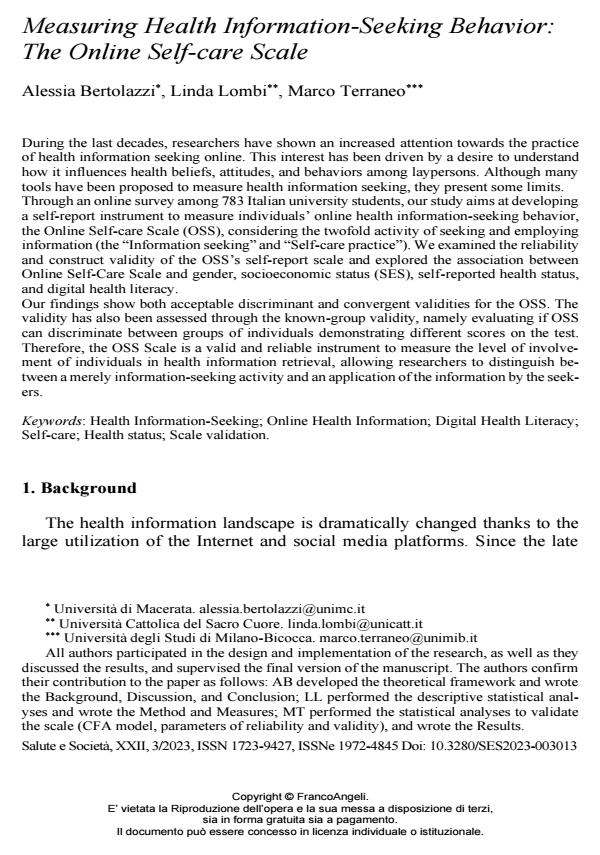Measuring Health Information-Seeking Behavior: The Online Self-care Scale
Titolo Rivista SALUTE E SOCIETÀ
Autori/Curatori Alessia Bertolazzi, Linda Lombi, Marco Terraneo
Anno di pubblicazione 2023 Fascicolo 2023/3
Lingua Inglese Numero pagine 19 P. 177-195 Dimensione file 506 KB
DOI 10.3280/SES2023-003013
Il DOI è il codice a barre della proprietà intellettuale: per saperne di più
clicca qui
Qui sotto puoi vedere in anteprima la prima pagina di questo articolo.
Se questo articolo ti interessa, lo puoi acquistare (e scaricare in formato pdf) seguendo le facili indicazioni per acquistare il download credit. Acquista Download Credits per scaricare questo Articolo in formato PDF

FrancoAngeli è membro della Publishers International Linking Association, Inc (PILA)associazione indipendente e non profit per facilitare (attraverso i servizi tecnologici implementati da CrossRef.org) l’accesso degli studiosi ai contenuti digitali nelle pubblicazioni professionali e scientifiche
During the last decades, researchers have shown an increased attention towards the practice of health information seeking online. This interest has been driven by a desire to understand how it influences health beliefs, attitudes, and behaviors among laypersons. Although many tools have been proposed to measure health information seeking, they present some limits. Through an online survey among 783 Italian university students, our study aims at developing a self-report instrument to measure individuals’ online health information-seeking behavior, the Online Self-care Scale (OSS), considering the twofold activity of seeking and employing information (the “Information seeking” and “Self-care practice”). We examined the reliability and construct validity of the OSS’s self-report scale and explored the association between Online Self-Care Scale and gender, socioeconomic status (SES), self-reported health status, and digital health literacy. Our findings show both acceptable discriminant and convergent validities for the OSS. The validity has also been assessed through the known-group validity, namely evaluating if OSS can discriminate between groups of individuals demonstrating different scores on the test. Therefore, the OSS Scale is a valid and reliable instrument to measure the level of involvement of individuals in health information retrieval, allowing researchers to distinguish between a merely information-seeking activity and an application of the information by the seekers.
Parole chiave:Health Information-Seeking; Online Health Information; Digital Health Literacy; Self-care; Health status; Scale validation.
- 2025 International Conference on Electrical, Computer and Communication Engineering (ECCE) Rowzatul Zannat, Abdullah Al Shafi, Abdul Muntakim, pp.1 (DOI:10.1109/ECCE64574.2025.11012950)
Alessia Bertolazzi, Linda Lombi, Marco Terraneo, Measuring Health Information-Seeking Behavior: The Online Self-care Scale in "SALUTE E SOCIETÀ" 3/2023, pp 177-195, DOI: 10.3280/SES2023-003013